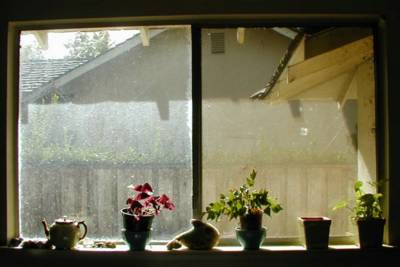ReviewOutsound Presents: LSG New Music Series @ Luggage Store Gallery, San Francisco
8:00 pmEmily Hay: Flutes, vocalMarcos Fernandes: PercussionRobert Montoya: Computer/softwareBob Marsh: electronically modulated vocal
9:00 pmMarcos Fernandes: PercussionRobert Montoya: Computer/softwareRent Romus: SaxaphonesErnesto Diaz-Infante: acoustic-electric steelstring guitar
8:00
Emily Hay, Marcos Fernandes and Robert Montoya traveled up from San Diego to perform with a couple of San Francisco locals for the February 23 2006 implementation of the LSG New Music Series. It made for a wonderful couple of hours of excellent, compelling music.
For the 8:00 show Emily Hay began by blowing her alto flute shakuhachi-like into her microphone. She progressed into including vocalizations with the flute blowing, and later alternating between the flute and vocalizations. Her vocal sounds ranged from english-like phonemes to sounds of laughter, but often coming back to a crystal-clear operetic voice, pitched and carefully articulated. Throughout the first set Emily alternated improvising between her flutes and her voice.
Bob Marsh seemed often to track Emily’s vocals, but did so by almost mumbling into a microphone which pitch-shifted and otherwise modulated his voice into pitches that did match, and timbres that almost matched those of Emily. While Emily was working hard to get volume, articulation and pitch, Bob kept up seemingly without effort, through excellent control of his electronics. The two played off each other, with Bob at times creating electronic loops, and Emily sometimes repeating.
Behind Emily and Bob, Marcos Fernandes had percussion instruments set up on and under a table, with a microphone picking up the sounds and feeding them into a Lexicon reverb module. occasionally with prerecorded sounds. The tabletop was recorded hot, with small sounds of rubbing a mallet across the face of a drum being picked up and amplified sometimes into the foreground of the sonic output. Marcos was well balanced between percussion and foley (sound effects) work, using pots, pans, drums, gongs, bells and other instruments and objects obviously chosen for their focused sonic qualities.
Robert Montoya sat in back with his computer, using Ableton Live software to loop a sound sample, select segments of that sample, and modifying its attributes in real time. his sounds were urban, percussive, often sounding like scraping metal, but never muddy.
After the first set, Emily sat down, and Rent Romus joined with three saxaphones, as did Ernesdo Diaz-Infante on guitar. Rent sent out saxaphone sound arcs and blurts, always sent into an opening in the sonic spectrum created by the others.
Ernesdo’s guitar strings were tuned down well below normal pitch so that when he struck them they were much more percussive than pitched. His right-hand work (strumming and picking) was his focus and was the most effective, setting up rhythms that provided tempos for the second set.
What struck me about this evenings’ music–other than the fact that it was among the most continuously compelling of the evenings I’ve heard here over the last few months–was that the instrumentalists often played musical roles different from those usually selected for their instruments:
Marcos’ percussion rarely provided enough repetition to create a tempo or rhythm. Rather, he delivered individual sounds that were each complex and defined enough to deserve attention on their own.
Ernesto’s guitar played no melody, nor did it provide a chordal harmonization. As I stated above, he provided the rhythm and tempo, using the detuned guitar as a percussion instrument, and drumming out a beat for the others to weave around.
Rent’s saxaphones provided phrases that rose from the bed of the sounds, arced above them and descended back into the source. Robert’s software provided a mostly arhythmic backdrop for the others, but filtered and pitched so that the overall sound was rarely muddy–always a problem for electro-acoustic performances.
Bob marsh’s electronically modulated vocalizations often approached the sound of a non-modified voice (though it always had just enough electronic artifacts to keep from sounding like it intended to imitate one). And Emily’s flute and vocal work were almost electronic.
What I think made the night for me was that the acoustic elements were so carefully modified toward the electronic, and the electronic was so carefully modulated toward the acoustic, that what was accomplished was a masterful blending of the two. It was not electronic, and it was not acoustic, nor did it alternate between the two: it was sonic. And for me, that worked wonderfully.
I continue to look forward to what the next week brings this series.
CDs Available from these groups: WE ARE on Publiceysore (Emily Hay and Marcos Fernandes)REVERBERATIONS FROM SPRING PAST on Pax Recordings (w/Rent Romus)

